Chapter 0, Standard pitch

 Chapter 1, Before selecting guitar, lute, or ukulele strings
Chapter 1, Before selecting guitar, lute, or ukulele strings

 Chapter 2, Things to consider in selecting strings
Chapter 2, Things to consider in selecting strings

 Chapter 3, About gut strings
Chapter 3, About gut strings

 Chapter 4.1, How to use a string slide rule (Pyramid's)
Chapter 4.1, How to use a string slide rule (Pyramid's)

 Chapter 4.2, How to use a string slide rule (Kuerschner's)
Chapter 4.2, How to use a string slide rule (Kuerschner's)

 Chapter 5, Manufacturers of string and how to contact them
Chapter 5, Manufacturers of string and how to contact them

 Chapter 6, Fishing line gauge
Chapter 6, Fishing line gauge

 Chapter 7, Some sample selections # Sample selections for guitar,Sample selections for telz guitar, Sample selections for lute
Chapter 7, Some sample selections # Sample selections for guitar,Sample selections for telz guitar, Sample selections for lute
-Chapter 0
Standard pitch

 What is a standard pitch?
What is a standard pitch?
Generally speaking, a standard pitch is the pitch used as a frequency reference (in Hz) for tuning a musical instrument. Usually either a tuning fork or an electric tuner are used, unless you are capable of determining an absolute pitch. Most electric tuners use A=440Hz (a1=440Hz) standard by a default, so the pitch an instrument tuned using these tuners shall be A=440Hz.
Instruments like guitar, lute, and ukulele are often used as a solo instrument, where the use of the standard pitch is not an absolute necessity. However, it becomes necessary, once you are to play with other instruments in duet or ensemble. Even in a solo situation, each instrument has its own "better sounding" pitch, because any instrument has a vibrating body which usually has a preferred frequency to resonate. Adjusting pitch means that string tension is altered, which also affects sound, sustain, playability of the instrument, and how much it is stressed (and possibly damaged). If you have an instrument made in or prior to 19th century, I'd strongly recommend you to use similar strings and pitch used at the period. This would lessen the possibility of damaging the instrument and recreate the sound people of the period had enjoyed.
According to Mr. Taro Takeuchi, a world renowned player of early stringed instruments, two different pitches coexisted in late 18th century England. Normal pitch used in homes and at practice was a half to full tone lower than the concert pitch. A violin method of the period is said to instruct "It is preferred to use lower pitch in practice, because lower tension makes easier to play and gentler for an instrument. It's more effective to limit the use of higher tension to a large concert hall where volume is required." I've also heard that A. Segovia used to tune his guitar a full tone higher at concerts with noisy audience.
Considering the fact that the pitch was chosen accordingly in the past, "where the instrument had been played" becomes as important a factor as its structure, the selection of strings, etc. In what situation a particular instrument used to be played? For whom it was played? They are intriguing questions to think about...

 Various standard pitches
Various standard pitches
In a modern era, it becomes normal to use A=440Hz (a1=440Hz to be more specific) as a standard pitch. But the standard pitch used in the past varied quite a lot depending on the locality and period. Tuning fork to tune music instruments was invented in early 18th century, widely used, and many of old ones survived in the world. Using these surviving specimens, it is possible to reconstruct how the standard pitch changes. Other than the tuning forks, surviving pipe organs and their music, surviving wind instruments pitch, etc. are used for the same purpose. Based on these evidences, heated arguments are often exchanged on the standard pitch of the past. According to references I can find, an abbreviated history of the standard pitch is the following,
In baroque era Germany, multiple standard pitches were used in 17th and 18th centuries, including the time of J.S. Bach. Chorton (c.465Hz/c.466Hz/c.440Hz) primarily used in churches and outdoors and Kammerton (c.392Hz/c.415Hz) used indoors are among them. Kammerton seemed to be a French pitch originally and brought into Germany by oppressed French protestants.
A standard pitch of 392Hz was said to be used in the palace of Versailles in France.
In 1711, John Shore, a trumpeter of the English Court, invented the tuning fork to tune his lute. It soon became widely used in the world.
In 1813, A=412Hz was adopted for orchestras in England (this was later raised to A=452Hz in 1859)
In 1839, A=440 was adopted in Stuttgart, Germany.
In 1858, French government adopted A=448Hz for opera.
In 1859, many tuning forks from all over Europe were brought to Paris in an effort of unifying the standard pitch. A=435Hz is adopted as an unified standard pitch.
In 1887, Italian government adopted A=435Hz.
Some said that usual standard pitch was around 430Hz till the later part of 19th century. But, after the turn of the century, A=440Hz became widely adopted in the world as "The New Philharmonic Pitch" starting in 1938. And now, the standard pitch has finally been settled in 440Hz, though many orchestras currently seem to adopt a little higher pitch of 442-446Hz.
It is regularly attempted to play Bach's organ music and other baroque era music in a standard pitch of the period. And the best way to reproduce the sound of the period for these music has been actively debated among the musicians. On the contrary, it is also popular to play baroque era violins in a modern pitch with a proper structural reinforcement.

 Ensemble and pitch
Ensemble and pitch
Are you aware the fact that the pitch of an instrument changes as the temperature? I tried to find a good example of this subject on the Internet and learned some experimental results are posted on wed sites for Syakuhachi (Japanese bamboo flute). This change seems to be often regarded a serious problem among wind players. According to these sites, the frequency of an instrument rises 4Hz as the temperature rises 5 degree in Celsius. It is quite possible to have a large temperature changes depending on a location and season of the concert. For example, room temperature in Wiener in winter may be around 10 degree and that in southern Italy in summer may be close to 30, which makes a temperature difference of almost 20 degree (therefore, 15Hz difference in frequency). It would be hard to keep a pitch high enough to be proper pitch in winter, without keeping the instrument warm somehow (especially hard in wind instruments).
How the pitch is adjusted differs from an instrument to another. Drums, for example, can be adjusted the tension of their skins to change pitch. In strings instruments, turning tuning pegs or using a capo are ways to change pitch. In wind instruments, pitch can be changed by sliding a head tube (thus changing tube length) slightly. If one tried to change too much, one starts to encounter problems like octave tone unbalance, etc. So, it is not possible to change wind instruments' pitch arbitrary. There are many old wind instruments with different pitches survive. It is probable that the other instruments in an ensemble had adjusted their pitch to a wind one, in the same way as orchestras are usually tuned today.
Musicians in the past must have been as conscious about how their instruments sound as modern counterparts. So, they had to alter pitch depending on the instrument composition, place (indoor/outdoor), and season of the concert. I can imagine that it must have been hard to use one unified standard pitch in every occasion for them.
In an ensemble with wind instruments, string instruments did probably adjust their pitch to match the one wind instruments could comfortablly use at each concert.

 Tune an instrument in a given pitch
Tune an instrument in a given pitch
Most of current electric tuners can set the standard pitch in 1Hz step between A=438Hz and A=445Hz. Then, how can one tune an instrument with A=415Hz or A=392Hz? I'm sure those who often the Crane web site are wise enough to answer this question. Yes, lower the tuning a half tone from A=440Hz to get A=415Hz pitch and lower a full tone to get A=392Hz, as described below. An octave higher in tone (8va) is twice in the frequency and an octave lower in tone (8vb) is a half in frequency. Now, automated chromatic tuners (detect and display a tone in a half tune step) can be obtained in a low price, and many of them can show the tone in a finer scale of cents. One of these for guitars can be purchased from 2000 yen or so.
A =
b1(493.9Hz): a full tone higher than 440Hz (+100cent)
a1#(465Hz): a half tone higher than 440Hz (+50cent)
a1(440Hz): modern standard pitch
g1#(415Hz): a half tone lower than 440Hz (-50cent)
g1(392.0Hz): a full tone lower than 440Hz (-100cent)
f1(349.2Hz)

 How tension and gauge of a string changes as pitch?
How tension and gauge of a string changes as pitch?
I wanted to compare tension and gauge quantitatively and did some calculations using a slide rule for string.
Suppose a string instruments has a certain "good sounding" tension (resonance frequency in a broader sense), which is the case for the most I saw, thinner gauge strings have to be used to obtain a higher pitch without changing a tension. One the other hand, thicker ones need to be used to lower the pitch.
For example, an old instrument played in late 18th century with a pitch of A=392Hz, which is a 6 single stringed guitar with a scale length of 630 mm and having an optimum tension of 5.0 kg, a 0.6 mm gut string has to be used to obtain this pitch. In this case, assuming the total tension is a simple sum of 6 strings with the same tension, the total will be 30 kg.
What gauge should be chosen to get the same tension for a different pitch?
Simplifying the results shown below, using 10% thiner string makes one get a full tone higher.
On the instrument mentioned above, 0.6mm gut string gives A=392 with string tension of 5.0kg.
On the same instrument, 0.57mm gut string gives A=415Hz with 5.0kg tension.
On the same instrument, 0.55mm gut string gives A=430Hz with 5.0kg tension.
On the same instrument, 0.54mm gut string gives A=440Hz with 5.0kg tension.
On the same instrument, 0.52mm gut string gives A=452Hz with 5.0kg tension.
How string tension changes as pitch, if one use the same strings?
For example, string tension increases 1.3kg, when the pitch is raised a full tone without changing the string. So, the total tension on a 6 stringed guitar increases by about 8kg.
With A=392Hz pitch, 0.60mm gut string needs to be strung by a tension of 5.0kg.
With A=415Hz pitch, 0.60mm gut string needs to be strung by 5.6kg tension.
With A=430Hz pitch, 0.60mm gut string needs to be strung by 6.1kg tension.
With A=440Hz pitch, 0.60mm gut string needs to be strung by 6.3kg tension.
With A=452Hz pitch, 0.60mm gut string needs to be strung by 6.9kg tension.
[IMPORTANT]
If one happens to use Augustine Regal's 1st string (nylon 0.76mm) on the same instrument with a modern pitch of A=440Hz, the string tension would be 8.6kg. The total tension exerted on the guitar in this case would increase by 22 kg and become 52 kg, which is no wonder that the instrument would be damaged.
As you can see above, the standard pitch used is an important factor in selecting strings. It may be interesting to select a new set of strings considering where you want to play your instruments or whether the use of the modern pitch is suitable for them or not.
-Chapter 1
Before selecting guitar, lute, or ukulele strings
As I wrote at the beginning of this section, a proper matching of "structure and material of an instrument", "string selection", and "how you play it" is the most important factor that determines sound of any stringed instrument, in my opinion. Unfortunately, this is not always the case and these elements often become unbalanced. The main gaol of opening this corner I hoped is at least to show how to select proper strings, thus to make it easier to balance the other two and to make more people happy with their instruments.
You can get strings for a variety of instruments in music shops these days. But, once you deviate from the norm, like being conscious about the sound or playability, playing a little unusual instrument that not so many other are playing, trying an ethnic instrument, or interesting in a "maniac" instrument, it becomes much harder to find strings or the selection becomes extremely limited even if you could find them in a certain music shop. If you searched wisely and followed proper suggestions, you would be able to find strings (or information for a particular instrument). You certainly know how to use the Internet, which is encyclopedia, yellow pages, and catalogs all combined, so search patiently.

 Lute/Baroque guitar/etc: You may have seen "6 course renaissance lute set", "5 course baroque guitar set", or "13 course baroque lute set" sold through the net. Considering scale length and tension appropriate to your instrument, however, it's extremely helpful to have a string slide rule (see Chapter 4 on how to use one). Other possibilities are to inquire the specialty instrument shop you've acquired your instrument or to ask your teacher to provide strings. It's a good idea to note gauge of the strings when you get them. You can even purchase an individual string at some web sites. Regarding the string slide rule, you can check string makers listed in this site. Or, you can try a gauge calculation software for Windows ("StringCalc" developed by a British luthier Mr. Oliver Wadsworth). You also can use the "link" and "shop information" section of this site as a reference. As far as I know, Pyramid and Kuerschner are selling string slide rules. NRI also sells a string calculation chart with an instruction manual for 1 pound. You may be able to use some unusual strings, by using one of these.
Lute/Baroque guitar/etc: You may have seen "6 course renaissance lute set", "5 course baroque guitar set", or "13 course baroque lute set" sold through the net. Considering scale length and tension appropriate to your instrument, however, it's extremely helpful to have a string slide rule (see Chapter 4 on how to use one). Other possibilities are to inquire the specialty instrument shop you've acquired your instrument or to ask your teacher to provide strings. It's a good idea to note gauge of the strings when you get them. You can even purchase an individual string at some web sites. Regarding the string slide rule, you can check string makers listed in this site. Or, you can try a gauge calculation software for Windows ("StringCalc" developed by a British luthier Mr. Oliver Wadsworth). You also can use the "link" and "shop information" section of this site as a reference. As far as I know, Pyramid and Kuerschner are selling string slide rules. NRI also sells a string calculation chart with an instruction manual for 1 pound. You may be able to use some unusual strings, by using one of these.
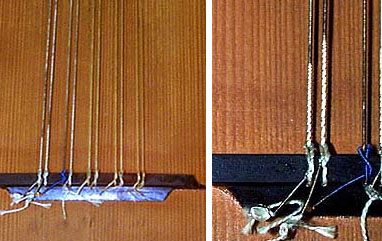

 Uke: A variety of ukulele strings are available at music shops in Japan. They are usually sold as a set of strings. Recently, it becomes popular to use a low G tuning, namely tuning the 4th string in G one octave lower than usual. In this case, 4th string for guitars can substitutes 4th uku string, but it's better to choose a proper tension one to get better sound and less stress on the instrument. Ideally, the string slide rule should be used to choose a optimum tension string even for your uku. You may say that's too tedious. I know that's an understandable complaint. But, some instruments change their sound depending on strings used and it's always interesting to know exactly how much tension your instrument is under. I happened to see an old ukulele made in late 1800 in a shop lately. If you have string slide rule, it's possible to think about using gut strings on it. It's a waste of time and money to keep changing string randomly without knowing what you are changing.
Uke: A variety of ukulele strings are available at music shops in Japan. They are usually sold as a set of strings. Recently, it becomes popular to use a low G tuning, namely tuning the 4th string in G one octave lower than usual. In this case, 4th string for guitars can substitutes 4th uku string, but it's better to choose a proper tension one to get better sound and less stress on the instrument. Ideally, the string slide rule should be used to choose a optimum tension string even for your uku. You may say that's too tedious. I know that's an understandable complaint. But, some instruments change their sound depending on strings used and it's always interesting to know exactly how much tension your instrument is under. I happened to see an old ukulele made in late 1800 in a shop lately. If you have string slide rule, it's possible to think about using gut strings on it. It's a waste of time and money to keep changing string randomly without knowing what you are changing.

 Modern Guitar: There is a plenty of strings for modern classical guitars to choose from and they are widely available including those from ProArte and Augustine. Considering scale length, string angle at the bridge, action, and sound to select strings.... well, you may get confused on too many choices. Even some professional guitarists do not know how much tension their instruments are under. It is important how the string feel when they are played, but it's equally important to know the string material and tension while comparing strings. To find strings which are good in sound and playability, and comfortably tensioned for an instrument at the same time seems to be a difficult task, if not impossible. The string tension on the modern guitars sometimes exceeds 8 kg (50 kg in the total tension) and it seems to be increasing in recent years. Even using a "low tension" string set, the total tension exceeds 40 kg. Also, the definition of high and low (sometimes called light) tension varies among string makers. It's quite common to see a difference in tension among "low tension" strings.
Modern Guitar: There is a plenty of strings for modern classical guitars to choose from and they are widely available including those from ProArte and Augustine. Considering scale length, string angle at the bridge, action, and sound to select strings.... well, you may get confused on too many choices. Even some professional guitarists do not know how much tension their instruments are under. It is important how the string feel when they are played, but it's equally important to know the string material and tension while comparing strings. To find strings which are good in sound and playability, and comfortably tensioned for an instrument at the same time seems to be a difficult task, if not impossible. The string tension on the modern guitars sometimes exceeds 8 kg (50 kg in the total tension) and it seems to be increasing in recent years. Even using a "low tension" string set, the total tension exceeds 40 kg. Also, the definition of high and low (sometimes called light) tension varies among string makers. It's quite common to see a difference in tension among "low tension" strings.

 19th C.-Guitar: 19th century guitars, which this site is promoting, also require a careful string selection. If modern classical guitar strings are used on these instrument, total tension would be too much in most case. It's better on sound and for the instrument, to look for strings with a proper tension (though, I'm not saying "lower the better"). When a 19th century guitar is purchased, it is often strung with modern guitar strings, regardless of whether it is from a shop or a private owner. These strings may sound powerful, but will cause a permanent damage to the instrument if used continuously. In principle, a 19th century guitar should be able to generate enough volume and projection by gentle touches. For the sake of conserving the instrument alone, using strings for lutes or baroque guitars should be a viable alternative. Make sure to calculate tension for the scale length beforehand. Another alternative would be using low tension (or light tension) version of modern classical guitar strings. If these alternatives are not readily available, try to use regular classical guitar strings by shifting one, namely using the 1st string on 2nd, etc. In this case, fishing line could be used for the 1st string. Nylon string had first been used as guitar strings in 20th century, therefore an explanation on gut strings originally used on these instruments can be found in a separate section. Gut strings can be purchased at the early instrument shops or mail ordered. Or, you can acquire these strings directly from the manufacturers in Germany, Italy, or the US.
19th C.-Guitar: 19th century guitars, which this site is promoting, also require a careful string selection. If modern classical guitar strings are used on these instrument, total tension would be too much in most case. It's better on sound and for the instrument, to look for strings with a proper tension (though, I'm not saying "lower the better"). When a 19th century guitar is purchased, it is often strung with modern guitar strings, regardless of whether it is from a shop or a private owner. These strings may sound powerful, but will cause a permanent damage to the instrument if used continuously. In principle, a 19th century guitar should be able to generate enough volume and projection by gentle touches. For the sake of conserving the instrument alone, using strings for lutes or baroque guitars should be a viable alternative. Make sure to calculate tension for the scale length beforehand. Another alternative would be using low tension (or light tension) version of modern classical guitar strings. If these alternatives are not readily available, try to use regular classical guitar strings by shifting one, namely using the 1st string on 2nd, etc. In this case, fishing line could be used for the 1st string. Nylon string had first been used as guitar strings in 20th century, therefore an explanation on gut strings originally used on these instruments can be found in a separate section. Gut strings can be purchased at the early instrument shops or mail ordered. Or, you can acquire these strings directly from the manufacturers in Germany, Italy, or the US.
By the way, not all the 19th century guitars used lower tension than the modern ones. There remains some that seemed to have used tension comparable to the modern instruments or even higher. Some said that Shelly guitar (see NRI web site) used tension of about 10kg per string. There were some unusual cases, including rare one mentioned above.
The picture shown below is a French 19th century guitar which suffered cracks on its top, probably due to the use of steel strings on it. You can see the damage at each side of the top and around the joint with the finger board, 4 cracks in all. A bridge of this instrument had been severely damaged, too.
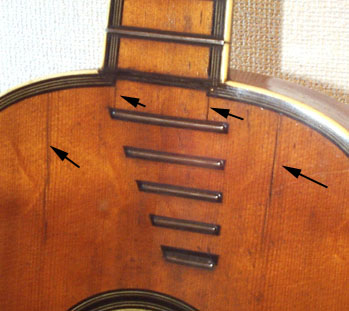

 Steel-String Guitar: Selecting strings for steel string or electric guitar is no exception for their own problems. You may think that there is not much a problem on adjustment of the mechanical bridge and locking mechanism, but there is many problems like choking and strings with not enough tension. Some ethnic instruments used steel strings of the same gauge?? Tension of steel strings tend to be higher than nylon and thicker gauge ones of these make me clinch my tooth just to play some codes. Grunt at each code changes... As early as 1903, Gibson adopted steel strings to their arch-top guitar, like L-O model. Thick gauge string seemed to be often used on these earlier steel string guitars and I have seen some period instruments that have a surprisingly thick neck to accommodate extreme tension of these.
Steel-String Guitar: Selecting strings for steel string or electric guitar is no exception for their own problems. You may think that there is not much a problem on adjustment of the mechanical bridge and locking mechanism, but there is many problems like choking and strings with not enough tension. Some ethnic instruments used steel strings of the same gauge?? Tension of steel strings tend to be higher than nylon and thicker gauge ones of these make me clinch my tooth just to play some codes. Grunt at each code changes... As early as 1903, Gibson adopted steel strings to their arch-top guitar, like L-O model. Thick gauge string seemed to be often used on these earlier steel string guitars and I have seen some period instruments that have a surprisingly thick neck to accommodate extreme tension of these.
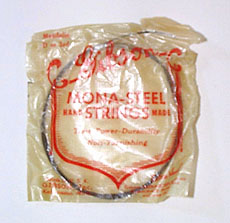
Martin also started to make steel string guitars as custom order in early 1900 and made these as regular model in 1922. Steel string guitars (we called them pick guitars in the past and fork guitars from 70's in Japan) gained its popularity in 1920's and 30's.
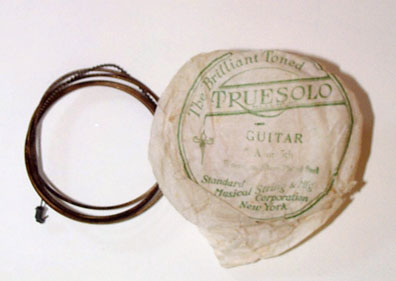
Brass wire had been available before steel one, but the popularity of metal wire as strings for musical instruments really started with an invention of piano wire at the industrial revolution. While there was not much interest in 19th century guitars in mid 1900, those made by Lacote and Stauffer were often mistaken as a steel string guitar and strung with steel strings. Thereby, the higher tension of steel strings have damaged many of them. Even now, I often see early 19th century Martin guitars strung with high tension steel strings (some steel wound strings exert as much as 15kg per string of tension). For mandolins, Maxima's seems to be popular for classical ones with bowl back. But, you must be careful to use them on Style-A of Martin or Gibson's, because their scale length and bridge structure is different from bowl backed ones. I saw a professional using completely inappropriate strings on a surviving baroque mandolin. Some players, even pro's, do not pay much attention to strings they use.
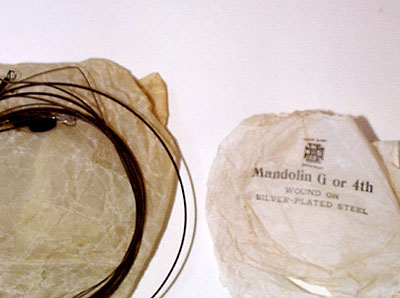
Higher tension of steel strings demands changes in structure of an instrument, like installing a rod into its neck and adopting an X bracing. As can be seen on D-28, Martin tried different points for this X bracing as time to find the best position. By the way, I tried to play friend's D-28 long time ago and I couldn't deal with its tension. Well, I must have been optimized for nylon or gut strings!? Even before the use of steel strings on guitars became popular, some metal strings had been used for chemballos and some chitarrones. Are metal strings actually used for guitar before 19th century along with gut ones? In the past, there were instruments quite similar to guitar, like Chitarra battente, and it's interesting to know whether metal strings were used one of these or not. I need to investigate further on metal strings.
- Chapter 2
Chapter 2
Things to consider in selecting strings

 Scale length : At the same pitch, longer the scale length higher the tension is and vise versa.
Scale length : At the same pitch, longer the scale length higher the tension is and vise versa.
The scale length of many 19th century guitars are around 620mm, while that of most modern classical guitars are 650mm or longer. The latter use the resulting higher tension to increase volume, projection, and sustain of the instruments. Ramirez has a 664mm model, for example. Modern classical guitars tend to have deeper bodies and larger sound board area in recent years. It is my personal impression that an use of a slant bracing bar by Ramirez is meant more to withstand higher tension than to get better sound characteristics. By the way, a bracing scheme using a slant bar can be seen on many guitars besides Ramirez', though Jose seemed to have acquired a patent on it. Instruments that use multiple steel strings per course, like Gibson's mandolins and so called 12 string fork guitars, should be under extremely high tension. Strings by Gibson in average seem to be in a slightly higher tension than others.

 String angle at saddle and nut : You have to be careful on the angle at the point where the strings are supported. Larger the bending angle of the string at saddle, greater the force exerted onto the sound board (or vise versa) becomes. Higher the string tension, more the volume tends to be generated by an instrument. At the same time, more force is needed to hold down the strings by left hand and to play them by right hand. A luthier told me that a 19th century guitar (he was talking about French style instrument) would be certainly damaged when tension of 8kg/string were used like modern classical guitars. It seemed better for a 19th century guitar to strung with a tension of 4~6 kg/string and to adjust such a way that it responds slight touch of both hands. You are to play an instrument that was used with high tension at the period, though, you have to string it accordingly. It often is the case that the appropriate tension of instruments depends on their type (locality, period, and structure), even when the scale lengths are the same.
String angle at saddle and nut : You have to be careful on the angle at the point where the strings are supported. Larger the bending angle of the string at saddle, greater the force exerted onto the sound board (or vise versa) becomes. Higher the string tension, more the volume tends to be generated by an instrument. At the same time, more force is needed to hold down the strings by left hand and to play them by right hand. A luthier told me that a 19th century guitar (he was talking about French style instrument) would be certainly damaged when tension of 8kg/string were used like modern classical guitars. It seemed better for a 19th century guitar to strung with a tension of 4~6 kg/string and to adjust such a way that it responds slight touch of both hands. You are to play an instrument that was used with high tension at the period, though, you have to string it accordingly. It often is the case that the appropriate tension of instruments depends on their type (locality, period, and structure), even when the scale lengths are the same.
Because shorter scale length results lower tension, there seems to be little problem using modern classical guitar strings with a typical scale length of 650mm on a 19th century guitar of 630mm. But, the strings seem to be too thick and tension feels rather high, if this is attempted. Many 19th century guitars use pins to affix strings at the bridge and higher saddle, which apply more pressure on the sound board than modern guitar with the same string tension. You have to be careful about the angle at the saddle.
The following two pictures show bridges of two 19th century guitars which are unaltered and in an original condition. I took these while adjusting saddles in repairing processes. The guitar on left has not much string bending at the saddle and one on right has a higher saddle which makes the bending angle larger. These are the differences that existed at the time they were made.
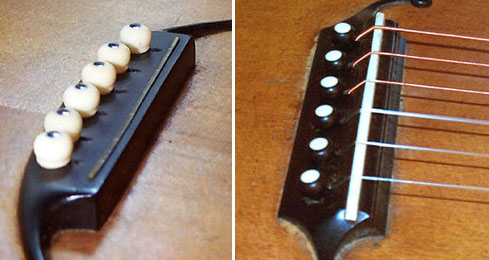
The next photo shows Spanish (or Portuguese) guitar made around 1820. The photo was taken while changing strings after a repair. A part of bridge structure acts as a saddle, therefore the saddle height and string angle at the saddle changes as the bridge wares down. Tension also should change slightly. It is quite similar to the bridge of modern classical guitars.
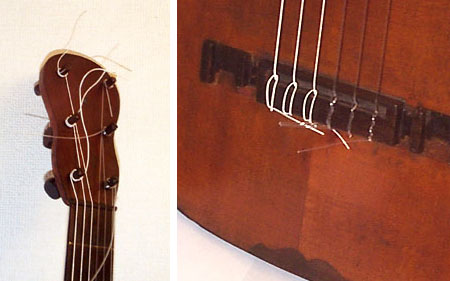

 Bracing scheme : instruments with fan bracing seem to sound better with higher tension.
Bracing scheme : instruments with fan bracing seem to sound better with higher tension.
Many modern guitars adopt a fan bracing scheme, but 19th century guitars tend to use a few parallel bars. Some say that instruments with fan bracing by Panormo seem to sound better with relatively high tension. But, Panormo made a variety of instruments and there remains a few of his having a very thin sound board. I would say that it depends on the individual instrument. There exists some instruments with fan bracing scheme originated from Panormo that sound better with lower tension. Many recent classical and steel string guitars are made with complex bracing schemes, like Kasha bracing, which tend to be designed to withstand more tension. The body size tends to become larger with larger sound board area and thicker body.

 Density of string : Heavier strings tend to generate low tone and lighter ones high.
Density of string : Heavier strings tend to generate low tone and lighter ones high.
Metal wound, fluorocarbon, gut, and nylon are typical string material in an order of density (high to low). One can use fluorocarbon lines sold as " Seaguer" from Kureha chemical in fishing supply shops. Nylon fishing lines can also be used on stringed instruments if they are proper gauge ones. Gut strings can be found at music shops specialized in early string instruments. Ground nylon strings and plastic wound strings for treble are sold by Savarez and others. ProArte by D'Addario and Augustine strings are popular among modern classical guitar players. Hannabach seems to use a different scale on string tension and their "normal tension" seems to be harder than some "hard tension" ones of other companies. As special cases to increase string density, there are twisted multiple gut strings, metal wire wound over gut strings, metal powder doped gut strings, etc. You can also find metal salt loaded gut strings distributed by early string makers. Among gut strings, those with extra twist to increase density are called "high twist". Among ukulele strings, there is a set of all wound strings for Dobro uku's.

 Tuning pitch : Modern pitch is A=440Hz, but the standard pitch used in 19th century was A=430Hz (1/4 tone lower) or A=435Hz.
Tuning pitch : Modern pitch is A=440Hz, but the standard pitch used in 19th century was A=430Hz (1/4 tone lower) or A=435Hz.
I used to use Hannabach's "Super low tension" in A=415Hz, because this is exactly a half tone lower than modern pitch. But, this tuning is not practical to play in an ensemble. Currently, I usually use strings for early instruments in 440 Hz. It's common to use A=440Hz and better to select strings for that pitch in an ensemble. For an audience with an absolute pitch, it may be hard to listen other than 440 Hz ;-P.

 Playing with nail or finger tip : It is preferable to use higher tension for playing with nail and lower tension with finger tip.
Playing with nail or finger tip : It is preferable to use higher tension for playing with nail and lower tension with finger tip.
This summarizes the tendency of many people's observations. Though, it's not an easy problem to answer, because personal preferences take a large part in judging playability, sound, and volume of an instrument. Personally, I use very short nail for playing single string (19th century, modern classical, or flamenco) and double string guitars, ukuleles, and steel string instruments, though not skilled enough to change touch depending on the instrument. Even period lute players had played either with nail or finger tip. Some references claim that lutenists do not use nail, but this is not true. However, finger tip playing may have some advantages on playing double stringed instruments.

 1st string (course) tends to stretch easily : this is especially true for thin gauge nylon.
1st string (course) tends to stretch easily : this is especially true for thin gauge nylon.
It seems better to use slightly thicker gauge string for 1st one than required. There is a side effect of a melody line being clearer with this.
-Chapter 3
About Gut string

 Gut string is made of sheep gut, which is the small intestine of sheep cleaned of any content and made to be thin skinned tube. If you fill this with some meat, you will come up with sausages. If you stretch and twist this, you can make strings. How exactly to make a gut string often guarded as a secret and details on the production process are hard to find in references. In any event, there are a few manufacturers and distributors of gut strings available at present.
Gut string is made of sheep gut, which is the small intestine of sheep cleaned of any content and made to be thin skinned tube. If you fill this with some meat, you will come up with sausages. If you stretch and twist this, you can make strings. How exactly to make a gut string often guarded as a secret and details on the production process are hard to find in references. In any event, there are a few manufacturers and distributors of gut strings available at present.

 Gut strings are distributed by Aquila in Italy, Savarez, EMS (Early Music Shop brand), Kuershner, NRI, and Pyramid among others. In Japan, Guitarra (Tokyo Early Instruments Center) is selling gut strings and strings for lute. In recent years, more shops are selling gut string in mail order. I usually purchased gut strings by importing them personally.
Gut strings are distributed by Aquila in Italy, Savarez, EMS (Early Music Shop brand), Kuershner, NRI, and Pyramid among others. In Japan, Guitarra (Tokyo Early Instruments Center) is selling gut strings and strings for lute. In recent years, more shops are selling gut string in mail order. I usually purchased gut strings by importing them personally.
There is higher density gut strings like high twist ones or others specially treated in the production process. On the other hand there are gut strings used for frets of baroque guitar or lute, which are sold as "fret gut" and seem lightly twisted ones.
Photo below shows a set of strings for a 19th century guitar I obtained from NRI of England. 1st and 2nd are low twisted and ground strings. 3rd string is high twisted and ground one. 4th alone is so called "catline", which is a gut string twisted like a rope. 5th and 6th are silver plated copper wire wound over silk. Their thicknesses are,
e': 22.5thou
b: 27thou
g: 34thou
d: 45thou
A: 60thou
E: 80thou
Unit "thou" used above means a thousandths of an inch. One inch is 25.4 mm, so multiplying these numbers by 25.4 then dividing by 1000 will give the thickness in mm. 22.5 times 25.4 is 571.5, therefore the 1st string thickness is 0.5715 mm. Doing the same math for the other strings and one can get 2nd: 0.6858 mm, 3rd: 0.8636 mm, 4th: 1.142 mm, 5th: 1.524 mm, and 6th: 2.032 mm.
By the way, a name "catline" seems to originate from a rope used to moor a ship's anchor. This 4th string is a rope like one with 3 gut strands twisted together. In a photo below, 3rd, 4th and 5th strings are shown.
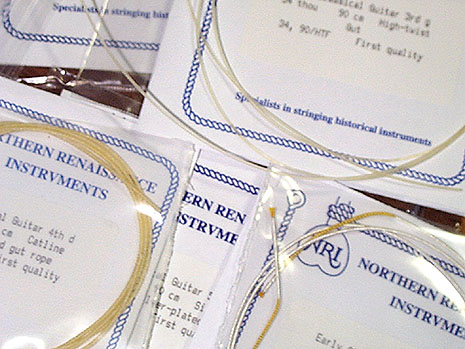
Thanks to the Internet, very deep strings like strand twisted gut and silver wire wound gut strings can be obtained rather easily these days. Personally, I use Pyramid's or Kuershner's partly because they make string slide rules.

 The popularity of nylon guitar string has started in the era of Segovia after the WW-II and gut strings had been the string on guitars before. Although they are little more expensive, please try the gut strings, too. I sometimes use gut strings and they don't last long. Actually, people tend to think the sound of used gut strings without higher harmonics favorably. 19th century guitars sometimes change their sound greatly when the strings are changed to gut. But for those who accustomed with the sound of steel string and modern classical guitars, the sound of gut string may be felt lacking brightness.
The popularity of nylon guitar string has started in the era of Segovia after the WW-II and gut strings had been the string on guitars before. Although they are little more expensive, please try the gut strings, too. I sometimes use gut strings and they don't last long. Actually, people tend to think the sound of used gut strings without higher harmonics favorably. 19th century guitars sometimes change their sound greatly when the strings are changed to gut. But for those who accustomed with the sound of steel string and modern classical guitars, the sound of gut string may be felt lacking brightness.

 There is two different finish used on gut strings. One is varnish primarily for plucking instruments and the other is oil for bowed instruments. Some string makers distribute finishing varnish, also. Pyramid sells oil for gut strings.
There is two different finish used on gut strings. One is varnish primarily for plucking instruments and the other is oil for bowed instruments. Some string makers distribute finishing varnish, also. Pyramid sells oil for gut strings.

 Players of early string instruments do not change strings often. It's not unheard of that some professional players change only once a year or two years. Broken in strings may be felt right on fingers? On the other hand, modern classical guitar players often change the string once a week or professionals sometimes change them every stage. While I was a student, I used to use them till they broke. Even these days, I change string very rarely (is this because I practice rarely?).
Players of early string instruments do not change strings often. It's not unheard of that some professional players change only once a year or two years. Broken in strings may be felt right on fingers? On the other hand, modern classical guitar players often change the string once a week or professionals sometimes change them every stage. While I was a student, I used to use them till they broke. Even these days, I change string very rarely (is this because I practice rarely?).
-Chapter 4.1
How to use string slide rule (#1)
Pyramid's string slide rule |

 Scale length, standard pitch, and tension are the important parameter.
Scale length, standard pitch, and tension are the important parameter.
You can find how to use a string slide rule below. This is a very deep subject, so you have to dig deep into your brain and read carefully.
The way to use a slide rule are quite similar on Pyramid's and Kuerschner's. I will start explaining how to use Pyramid's one first. Fortunately, this has an instruction in three languages on the back side. They are German, English and French, so Pyramid's is relatively easy to try, I hope.
As you can see in the photo, the slide rule is a white plastic sheet, inserted with narrow and wide rules. On the main body, there is many printed scales. You can choose appropriate strings of any material (nylon, fluorocarbon, gut, or metal wound), any scale length, and any tension. This gotta be a good stuff.
What is the difference between Pyramid's slide rule and Kuerschner's then, you may ask. The difference is the resulting products the slide rule will give. Especially on the wire wound strings, each uses their own company's product numbers. They both use basically the same principle, but they indicate different strings to be used. Although, I usually use fishing lines for nylon and fluorocarbon strings.
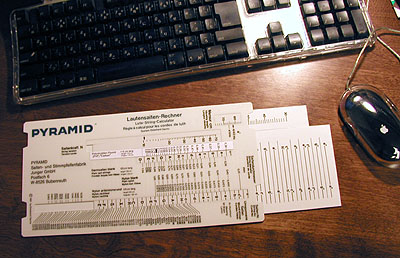
(1) Put the slide rule in portrait, namely in the position where the narrow rule can be pulled out from top.
First, determine the standard pitch, namely what frequency tone "A" should be. Then, take three deep breath.
Here, I will take a typical value of A=440 Hz. The word "Mensur" printed on top left means scale length of an instrument. For example, if you are using 19th century guitar with a scale length of 62 cm, move the narrow scale to make an arrow at 440Hz point the scale length of 62 (cm), as shown in the photo.
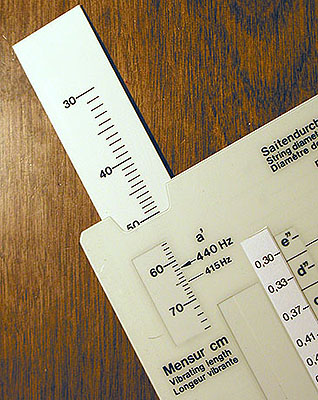
(2) Decide the tension you want to use in an unit of Newton (1kg = 2.2lb = 9.8N). Move the wide rule to match the proper tension value, while keeping the narrow one in the same place. For example, if you want to use a tension of 6.5kg (14lb), adjust the wide rule to align 64 on the scale to the arrow for the tension. This also is shown in the photo below.
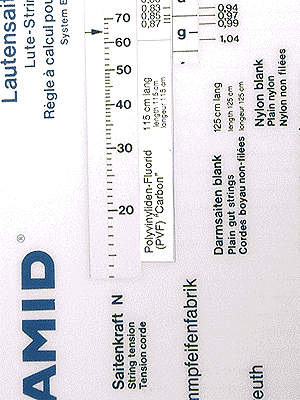
(3) Let's find the 1st sting, first. Only thing you have to do is to read the scale without moving two rules on it. For example, 1st string of guitar is expressed like e' or e1 in an absolute tone scale. So, take a look at e' on the scale. You may notice that there is numbers written on the both side of the scale and wonder which side should be used. In this slide rule, you should use one number or the other depending on the material of the string you are planning to use.
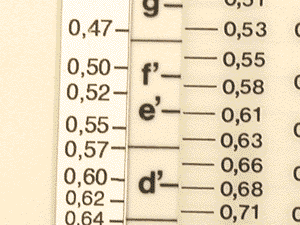
As you can see in a photo below, an e' string thickness in 6.5kg tension can be found for different material (fluorocarbon, gut, nylon, and metal wound from left to right). The thicknesses it indicates are 0.54mm for fluorocarbon, 0.61mm for gut, and 0.675mm for nylon. There is even metal wound strings shown in further right, so you can try 909Al metal wound, if you can come up with one. In case there is no exact string matched for a tone, one that is the closest should be used. On the right end of the slide rule shows Pyramid product numbers of metal wound strings.
Darmsaiten: gut
PVF: fluorocarbon ("Seager" etc.) : paper scale pasted on top :-)
Nylon: nylon
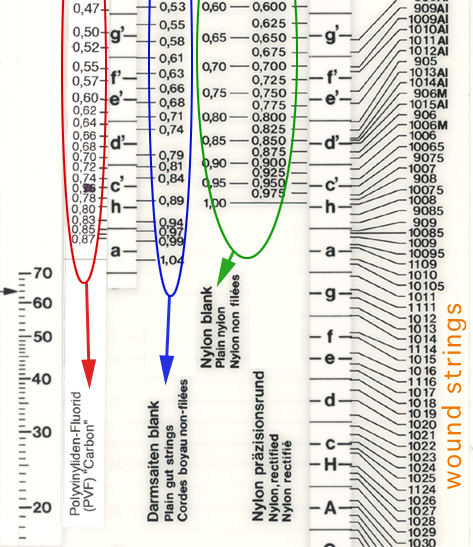
Repeat the same procedure, (2) - (3), on the other strings to get the thicknesses. You can find tone names in the reference section of this corner. In case of an usual guitar tuning, the following are the tones for each string,
1st(e'), 2nd(b=h),
2nd(b=h), 3rd(g),
3rd(g), 4th(d),
4th(d), 5th(A),
5th(A), 6th(E)
6th(E)
It's very common to use string(s) on the 1st course in higher tension than others on lute, 19th century guitar, and modern guitar. When the 1st string is used with 6.5 kg tension like the example above, that for the other strings should be around 5.8 kg (or that's what I would do). Of course, this depends on the type and structure of the instrument and personal preferences on sound and playability. Keep in mind, though, not to use too high a tension. It's wrong to think higher tension always guarantee more volume and projection. Strings have to be used in tension properly matched to the instrument to get the best result.
Have you master how to use the string slide rule, yet?
Addendum 1: In the procedure (3), it is also possible to find the string tension with a fixed string thickness. So, you can calculate how much tension a string is under, by using this slide rule and a micrometer. You can find a tension of between 1 and 7 kg, using Pyramid's slide rule.
Addendum 2: By the way, there is a few other features on the back side of the slide rule. "graduation tension" is one of them and a setting of string tension which decreases as the course number becomes larger.
Addendum 3: As I mentioned in the other chapters, appropriate strings may differ even for instruments with the same scale length, depending on their bracing scheme, string bending angle at saddle, etc. The best way is to actually try ones on the instrument with different selection criteria.
Addendum 4: Knowing the character of the strings you usually use is very important, because they can serve as a good reference for changing strings. For example, you want to change tension a little lighter (or harder) or to change from nylon to fluorocarbon. Or you want to change a tension a little after switching to gut string, etc. With this string slide rule, experimenting on strings will gets much easier. You now can explore not only sound of the instrument, but also sustain, projection, balancing all the strings, volume adjustment, etc, etc.
Addendum 5: If you own a 19th century guitar, it's a must to try a set of gut strings. That will open a new horizon on your guitar music experiences.
Scale length, standard pitch, and tension are the important parameter.
Scale length, standard pitch, and tension are the points
This section is describing how to use Kuerschner's string slide rule. The detailed explanations will follow. It is another deep subject, so you have to dig deeper into your brain and read carefully.
How to operate Kuerschner's slide rule is quite similar to Pyramid's. However, Kuerschner's has an instruction only in German and it might be easier to understand to have translations of words used on it.
The following are English translation of German words used on the Kuerschner's string slide rule.
saiten: string
 phi: (phi) thickness of the string, diameter.
phi: (phi) thickness of the string, diameter.
aquivalenter: translated (equivalent).
Mensur: scale length.
Saitenkraft: string tension in an unit of Newton (N).
Fluor-Carbon(PVF): Fluorocarbon, namely "Seaguer" and others in fishing lines.
Nylon (NR): Nylon, namely treble strings in an usual guitar string set.
Stahl: stainless steel.
Darm: gut.
Nylgut(PE): Nylgut (nylon string similar to gut in its characteristics).
Kupfer: copper.
versilbert: plated.
By the way, it indicates lighter and harder tension scales along with the normal one, which are very useful.
extra leicht: extra light
leicht: light
(none marked): normal tension
stark: hard, strong
extra stark: harder, stronger
- Chapter 4.2
Chapter 4.2
How to use a string slide rule (Kuerschner's)
As you can see, it's a plastic sheet with two rules, one narrow and the other wide, inserted. There are many scales printed on the main sheet. You can choose appropriate strings of any material (nylon, fluorocarbon, gut, or metal wound), any scale length, and any tension. This gotta be a good stuff.
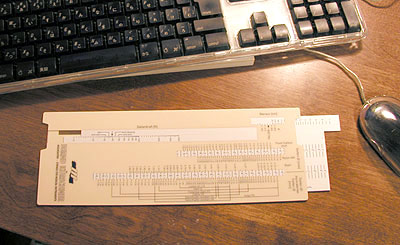
(1) First, you hold it in portrait, namely in a position where the rule can be pulled out to top.
Let's decide the standard pitch, namely deciding the frequency of A (like 440 Hz or 415 Hz). Then take three deep breaths.
I will use A=440 Hz in the following explanations. The word "Mensur" written on top left is the scale length, the length between the nut and saddle. Take a 19th century guitar with a scale length of 63 cm as an example, then adjust the narrow rule to match scale length 63 (cm) to an arrow indicating 440 Hz as shown in the following photo.
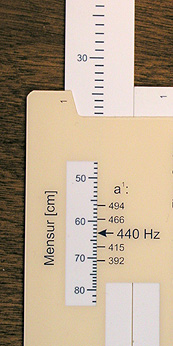
(2) Determine the string tension in an unit of force, Newton (1kg = 2.2 lb = 9.8N). Pull up the right side wider rule to match the proper tension value, while keeping the left one in the same place. For example, if you want to use a tension of 5.8kg (13 lb), adjust the wide rule to align 57 on the scale to the arrow on the tension. This also is show in the following photo.
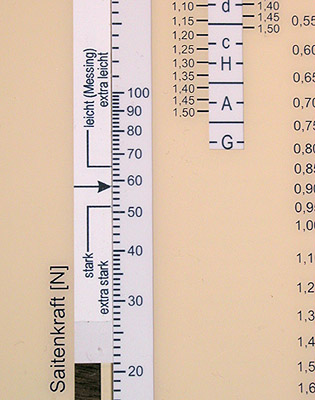
(3) Let's find the 1st sting, first. Only thing you have to do is to read the scale without moving two rules on it. For example, 1st string of guitar is expressed like e' or e1 in an absolute tone scale. So, take a look at e1 on the scale. You may notice that there is numbers written on the both side of the scale and wonder which side you should use. In this slide rule, you should use one number or the other depending on the material of the string you are planning to use.
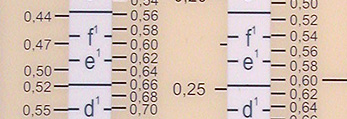
As you can see in a photo below, an e1 string thickness in 5.8kg tension can be found in different material (fluorocarbon, gut, nylon, and metal wound from left to right) The thicknesses it indicates are 0.50mm for fluorocarbon, 0.58mm for gut, and 0.62mm for nylon. By the way, if you want a steel string, the thickness you need is approximately 0.25mm. You can't choose any thickness in strings, unfortunately. So, you have to choose something close to the indicated thickness.
Darmsaiten: Gut
Fluor-CarbonPVFÄF fluorocarbon (like "Seaguer" in fishing lines)
Nylon: Nylon (regular fishing lines)

(4) Repeat the same procedure, (2) - (3), on the other strings to get the thicknesses. You can find tone names in the reference section of this corner. In case of usual guitar tuning,
1st(e1),2nd(b=h),3rd(g),4th(d),5th(A),6th(E)
As you can see in the following photo, 2nd string (b=h) would be 0.66mm in fluorocarbon, 0.85mm in nylon, or 0.76mm in gut.
How metal wound string should be selected, then? When you are choosing 5th (A) string, for example, the thickness of the string would be 1.45 mm in fluorocarbon and 1.70 mm for gut. Kuerschner uses an equivalent gut thickness in hundredth of mm as a part of product number of the metal wound string. There is a few candidate that is equivalent to a gut string of 1.70mm thickness. On the right side of this slide rule, VD, VN, etc. are printed to indicate the range of these products. For example, if you want to use silver plated wire wound over nylon on this guitar, the length code has to be used is "5". So, you should order VN5170.
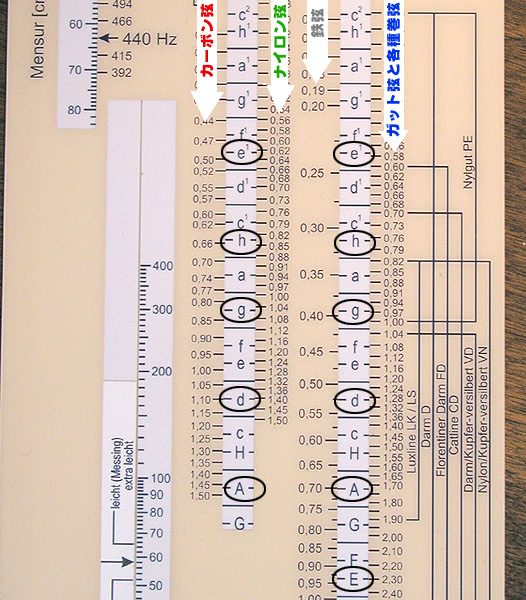
It's common to use string(s) on the 1st course in higher tension than others on lute, 19th century guitar, and modern guitar. When 5.8 kg tension is used on the 1st string like the example above, the tension of the other strings should be around 5.2 kg instead of 5.8 kg (or that's what I would do). Of course, this depends on the type and structure of the instrument and personal preferences on sound and playability. Keep in mind, though, not to use too high a tension. It's not right that higher tension always guarantee volume and projection. Strings have to be used in tension properly matched to the instruments to get the best result.
Have you master how to use the string slide rule, yet?
Addendum 1: In the procedure (3), it is also possible to find the string tension with a fixed string thickness. So, you can calculate how much tension a string is under, by using this slide rule and a micrometer.
Addendum 2: By the way, there is a few other features on the back side of the slide rule. "graduation tension" is one of them and a setting of string tension which decreases as the course number becomes larger.
Addendum 3: As I mentioned in the other chapters, appropriate strings may differ even for instruments with the same scale length, depending on their bracing scheme, string bending angle at saddle, etc. The best way is to actually try ones on the instrument with different selection criteria.
Addendum 4: Knowing the character of the strings you usually use is very important, because they can serve as a good reference for changing strings. For example, you want to change tension a little lighter (or harder) or to change from nylon to fluorocarbon. Or you want to change a tension a little after switching to gut string, etc. With this string slide rule, experimenting on strings will gets much easier. You now can explore not only sound of the instrument, but also sustain, projection, balancing all the strings, volume adjustment, etc, etc.
Addendum 5: If you own a 19th century guitar, it's a must to try a set of gut strings. That will open a new horizon on your experiences of guitar music.
Addendum 6: The length code of Kuerschner's string is the following,
0 = 60cm 1 = 90cm 2 = 120cm 3 = 180cm 5 = 115cm 6 = 150cm
Addendum 7: The material used in Kuerschner's string are given in codes shown below,
D: Plain Gut DL: Varnished Gut NR: Rectified Nylon
PVF: Fluorocarbon PE: NylGut(Polyester) LK: Luxline
VN: Nylon& Silver Plated Copper VNG: Nylon& Silver Plated Copper (Higher tension)
-Chapter 5
Manufacturers of string and how to contact them
http://bibliotecadelaguitarra.com/es/articulo/7053/manufacturers-of-string-and-how-to-contact-them.html
 - Chapter 6
- Chapter 6
Fishing line gauge
Fishing line gauge

 Let me introduce some fishing lines that can be used on stringed instruments. I have been trying fishing lines of various makers and gauge without concentrating one manufacturer or brand. As you can see below, you can find lines that can be used as strings for various instruments, except for metal wound ones. I listed those I'm using, between 2.5 and 26 gauge. I was totally impressed to find 26 gauge "Seaguar" with an orange label in "Johshu-ya" (a large fishing supply store chain) in Hachioji. Because I was not expecting to find a line used for fishing a huge tuna in Hachioji where my office is and some call the Tibet of Tokyo. Even "Johshu-ya" in Shibuya (Central Tokyo) carries "Seaguar" only up to 20 gauge. I should not have taken Hachioji lightly. If you are walking in a fishing supply store with 26 gauge "Seaguar" in your shopping bag, other shopper may talk to you asking "Are you going to fish marlins in Pacific ocean?".
Let me introduce some fishing lines that can be used on stringed instruments. I have been trying fishing lines of various makers and gauge without concentrating one manufacturer or brand. As you can see below, you can find lines that can be used as strings for various instruments, except for metal wound ones. I listed those I'm using, between 2.5 and 26 gauge. I was totally impressed to find 26 gauge "Seaguar" with an orange label in "Johshu-ya" (a large fishing supply store chain) in Hachioji. Because I was not expecting to find a line used for fishing a huge tuna in Hachioji where my office is and some call the Tibet of Tokyo. Even "Johshu-ya" in Shibuya (Central Tokyo) carries "Seaguar" only up to 20 gauge. I should not have taken Hachioji lightly. If you are walking in a fishing supply store with 26 gauge "Seaguar" in your shopping bag, other shopper may talk to you asking "Are you going to fish marlins in Pacific ocean?".
By the way, Kureha Chemical Industry, the manufacturer of "Seaguar", produces a leader line specialized for a long line fishing of tuna, as a "Man-yuu" brand. It seems to be available between 40 and 200 gauge. Other than "Man-yuu", there is thick gauge lines, one of which is by DUEL. Even though DUEL produces lines made of fluorocarbon, their characteristics seems to be quite different from "Seaguar". Other than fluorocarbon lines, there is a nylon line coated with fluorocarbon. I've heard that this line is stretchy and not suitable for musical instruments.
Usually, the line becomes thicker as the gauge number. Also, one can find fractional gauge numbers like 3.5 and 4.75. You can't find 25 Magnum, though

 Tornado (100% fluorocarbon), Sunline
Tornado (100% fluorocarbon), Sunline
2.5 gauge ; 0.260mm diameter
3 gauge ; 0.285mm diameter

 DUEL (H.D carbon, polymer shield)
DUEL (H.D carbon, polymer shield)
According to company information, "This product utilizes polymer shield produced by resin composition method. It's hard to wrinkle, tolerant to rubbing and scratch, and strong at knots. It's designed for supreme strength, etc."
http://www.duel.co.jp/ (http://www.duel.co.jp/cat/d_leader/hd_carbon/hd_carbon.htm)
4 gauge ; 0.329mm diameter
5 gauge ; 0.367mm diameter
6 gauge ; 0.403mm diameter
7 gauge ; 0.435mm diameter
8 gauge ; 0.465mm diameter
10 gauge ; 0.559mm diameter
12 gauge ; 0.612mm diameter
14 gauge ; 0.661mm diameter
16 gauge ; 0.707mm diameter

 Seaguar Grand Max (100% fluorocarbon), Kureha Chemical Industry: red/gold label
Seaguar Grand Max (100% fluorocarbon), Kureha Chemical Industry: red/gold label
0.3 - 4 gauge are also available
5 gauge ; 0.370mm diameter
6 gauge ; 0.405mm diameter
7 gauge ; 0.435mm diameter
8 gauge ; 0.470mm diameter
10 gauge ; 0.520mm diameter

 Seaguar Ace (100% fluorocarbon), Kureha Ch. Ind.: green label
Seaguar Ace (100% fluorocarbon), Kureha Ch. Ind.: green label
0.2 - 10 gauge are also available
12 gauge ; 0.570mm diameter
14 gauge ; 0.620mm diameter
16 gauge ; 0.660mm diameter
18 gauge ; 0.700mm diameter
20 gauge ; 0.740mm diameter

 Seaguar (100 % fluorocarbon), Kureha Ch. Ind.: Orange label
Seaguar (100 % fluorocarbon), Kureha Ch. Ind.: Orange label
0.3 - 18 gauge are also available
20 gauge ; 0.740mm diameter
22 gauge ; 0.780mm diameter
24 gauge ; 0.810mm diameter
26 gauge ; 0.840mm diameter

 Kureha Chemical Industry :
Kureha Chemical Industry :
Most of the strings sold for guitar and lute seem to be produced as fishing lines. Not only nylon lines, but also fluorocarbon lines are available at fishing supply shops. Line diameters and corresponding gauge numbers are listed above, because they are displayed according to gauge in fishing supply shops. If you purchased a few appropriate lines for your instrument, you may be able to used them for a life. You should never inquire the sales person "do you have instrument strings". Well, I'm the one who did that at one store.
You will never be able to find them neither EMS not Guitarra.
ÄEKureha Chemical Industry : http://www.kureha.co.jp/

They carry a few lines of Seaguar and have been introducing new product lines.
Seaguar: It has an orange colored label and is available between 1 and 30 gauge. It is relatively stiff and its knot tends be be larger than one would like. However, this is the only one greater than 20 gauge is available. I obtained them in "Johshu-ya in Hachioji.
Seaguar Force : It has a blue label and is available between 1 and 10 gauge. Lately, this is overshadowed by "Seaguar Grand Max", introduced later. Softer than "Seaguar".
Seaguar Ace : This is supreme to regular "Seaguar" and very popular, though it's hard to find ones thicker than 12 gauge. It has a green label and is renowned world wide among early music players.
Seaguar Grand Max : Finally, this is Grand Max long awaited by enthusiasts of 19th century guitars. It has special coating on the surface, which makes it softer though strong against tension. This is an excellent product. Well, I'm not a sales person at fishing supply shop, am I? The one I recommend most is 10 gauge Grand Max.

 Torey :
Torey :
I'd like to remind you again that these are fishing lines and not intended to be used as strings for musical instruments. But, it's worth a try, in my opinion. Nylon fishing lines are relatively inexpensive even for thicker gauge and easier to find. This "Ginrin" (silver scale) is rather soft and stretchy, which may make this unsuitable for some instruments. But they are inexpensive and available in many gauge.
Torey http://f-net.torayfishing.co.jp/
Fishing lines made of nylon and fluorocarbon can be used as strings on musical instruments. There are many interesting products produced by Torey.
Information on their product line up can be found in http://f-net.torayfishing.co.jp/products/index.html. "Ginrin" is available from 0.4 to 30 gauge in nylon. "Ginrin Z" is available from 1.5 gauge. "Ginrin Soft", found in http://f- net.torayfishing.co.jp/products/sea1/ginrin_soft.html, deserves a special attention. Also, "Ishidai", http://f- net.torayfishing.co.jp/products/fune/ginrin_ishi.html, is available thick gauge ones like 16, 18, 20, 25, and 30 gauge.
Their web page is detailed, yet easy to understand, which is a good example of how web page should be.


 Additional information on fishing line.
Additional information on fishing line.
It became harder to get thicker gauge "Seaguar". Some fishing supply shops stopped carrying them as a regular stock item and required to order at least 5 rolls. You can call Kureha's leisure product division and inquire about the nearest shops that carry their product. They are well aware that some customers are using these on stringed instruments.
According to a source who works for Kureha chemical industry and is an enthusiast of mandolins, they produce a quite few of "Seaguar" with different characteristics in their product development process. I envy him on many "Seaguar" he can try on his instruments....
According to a renowned player of early stringed instruments, he sometimes brings "Seaguar" in his oversea trip as a souvenir to his musical friends. According to another professional player, some players who came to Japan for a concert tour bring "Seaguar" back as a souvenir. Among foreigners, "Seaguar" must be as famous as Geisha and Fujiyama.
 Chapter 7, Some sample selections
Chapter 7, Some sample selections
Sample selections ... for guitar
Regardless of modern guitar, 19th century guitar, or even other stringed instruments, there is some instruments that sound better (with rather subjective judgment in volume and fullness of tone, though) when it is tuned a half or one full tone lower. While winding up a string after changing it, you may notice a few points where the instrument resonates better. That's the "good sounding" point.
You will have to wind the string a little further to have it tuned. It must be very rare to have all the strings resonate well after tuning properly. Unfortunately, it usually passed the resonating point and stresses the instruments unnecessarily when it's tuned. If you are playing solo and there is no need to match with others, you can use the "good sounding" point for your instrument. It's not always necessary to tune the instrument with A=440Hz. You should use the good sounding pitch and strings without damaging the instrument and enjoy it.
Almost any strings in thickness and of material available can be obtained in Japan. They are so wide variety of them that one may mistake guitars are made for them in these days. If you feel your instrument does not sound right, you'd better try other strings without hesitation. String tension listed below are either from their package or from some publications in the past. I added some explanations on them.
Caution : String tension would have an error depending on scale length, structures of bridge and neck, and the standard pitch used. Please regard the following as a rough guide.

 People often say that Augustine Black is lighter tension. How light it is then, I would ask. I summarize total tension I found in one of magazines below. Their tension seem to be set to around 40 kg.
People often say that Augustine Black is lighter tension. How light it is then, I would ask. I summarize total tension I found in one of magazines below. Their tension seem to be set to around 40 kg.
Red : 42.5 kg/set
Blue : 42.0 kg/set
Black : 39.1 kg/set
Strings made of nylon and fluorocarbon can be substitute with fishing lines and their tension can be calculated with the string slide rule. However, the same cannot be done for bass strings which usually are metal wound strings and need to be supplied by string manufacturers. According to a tension measurement result in an article I found on a Japanese guitar publication, tension of bass strings of various manufacturer for modern classical guitars are, 4th: Yamaha Grand Concert 5.7kg, 5th: Augustine Black 6.35kg and Savarez Redcard High tension RE-D5 6.3kg, and 6th: Yamaha Classic Guitar String 5.9kg and Augustine Black 6.3kg. Savarez Redcard is relatively low tension, 4th: 7.3kg, 5th 6.3kg, and 6th: 6.7kg, despite of the fact that the package claims "high tension". In any events, tension per string generally exceeds 6kg. Some of the result published in the article I mentioned above seem to contradict with the numbers made public by manufacturers. So, you should take these numbers just as a rough guide.
Hannabach made tension of their strings public on their web site listed below. They are supplying strings at about 2kg increment in total tension.
http://www.hannabach-strings.com/index_nav.htm
Red label (SuperHighTension) : Total 45.4 daN (about 46.3kg)
Blue label (HighTension) : Total 44.3daN (about 45.2kg)
Diff. label (Medium High Tension): Total 43.1daN (about 44kg)
Black label (Medium Tension) : Total 41.1daN (about 42kg)
Green label (Low Tension) : Total 39.7daN (about 40.5kg)
Yellow label (Super Low Tension) : Total 37.0daN (about 37.7kg)
As you can see in Hannabach's products, stringed instruments like guitar change their characteristics like volume, sound, or touch greatly by changing tension by about 300g. Typically, a half tone change in tuning of a string causes its tension to change about 500g, so the change in total tension would be 3kg.
Many string manufacturers have adopted higher tension on 1st string compared to the others in order to make it sound louder and make a melody line clearer.

 In the following, I will explain details on how to select strings based on its material and tension.
In the following, I will explain details on how to select strings based on its material and tension.
Selecting bass (metal wound) strings |
You can substitute treble strings with fishing lines, but how about bass strings.
The string tension of ProArte hard tension is shown below. Total tension can be calculated to be 39.59kg, which is about 40kg and 6.6kg/string in average. By the way, the scale length ProArte uses as a standard is 648mm, according to its package. It should be noted that 1st and 4th string have a slightly higher tension than others.
[ProArte Hard Tension]
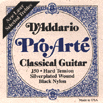
1st : 7.17kg, Nylon 0.74mm
2nd : 5.44kg, Nylon 0.85mm
3rd : 5.62kg, Nylon 1.04mm
4th : 7.44kg, Metal wound 0.76mm (equivalent to VN5145)
5th : 7.21kg, Metal wound 0.91mm (equivalent to VN5190)
6th : 6.60kg, Metal wound 1.12mm (equivalent to VN5240)
Now, the following shows tension of ProArte light tension strings. Although it often sounds rather thin on some modern guitars, it is still popular among women and those who lack grip strength. A certain type of modern guitar may have a good match with this string. When the entire set is used, the total tension is 35.43kg, according to the information on its package, and per string tension will be about 5.9kg. Thicker than other strings' gauge is used on 1st and 4th string.
You may think "I can use this one on a 19th century guitar as is." As a matter of fact, I have been using them on some 19th century guitars. If I force myself to find a weakness of this combination, bass strings tend to sound rather dull. 4th through 6th string of this set is silver plated wire wound over nylon strands. I have tried this string on genuine 19th century guitars of different types and scale lengths. My conclusion is that "it depends on the instrument." There is an individual difference even among the instruments of exactly the same type. So, it's better actually to try a few strings on the instrument and this ProArte light tension can be one of the candidates, because of their wide availability and low cost. It's also OK to use fishing lines on 1st through 3rd and ProArte on 4th through 6th.
[ProArte Light Tension]

1st : 6.7kg, Nylon 0.71mm
2nd : 5.08kg, Nylon 0.81mm
3rd : 5.3kg, Nylon 1.02mm
4th : 6.7kg, Metal wound 0.71mm (equivalent to VN5136)
5th : 5.67kg, Metal wound 0.84mm (equivalent to VN5165)
6th : 5.98kg, Metal wound 1.07mm (equivalent to VN5230)
19th century guitars having only horizontal bracing bars may not sound right with ProArte light tension, especially metal wound strings. I have tried them on short scale length (560 - 610mm) ones, but I felt it better to lower the tension down to like 4kg/string in order to get better results on sound and playability. Some people wrote a lengthy review on magazines, but I think relying on them is waste of time and it's best to find out by using on your own instrument. Yes, you got to find a good match between strings and the instruments.
The photo below has been taken while trying Seaguar Ace for treble and Kuerschner's copper wound strings for bass. The guitar is made in France around 1920 and quite similar in a configuration of bracing bars, a detailed structure, and its parts to what Lacote made then. It sounded great with the average tension of about 5kg.
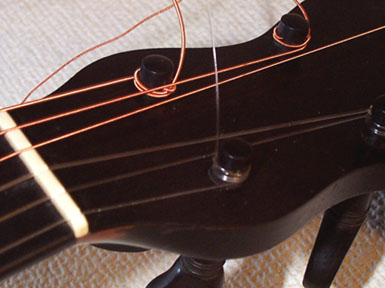
Selecting treble strings (Nylon, etc.) |
For strings of lute, baroque guitar, 19th century guitar, and ukulele, nylon and fluorocarbon are widely used. Alternatively, one can use fishing lines for most of them. By the way, Savarez makes plastic wound treble strings.
If you want to use fluorocarbon for treble strings, you can use Seaguar series mentioned below especially for guitars. Even guitar strings sold in music shops seem to be produced by fishing line makers. You can use the following among Seaguar Ace. When you are to try new strings, you may want to change sound of an instrument a little without changing tension. In this case, please refer to the sections of "Fishing line gauge" and "References". Obviously, string slide rule is very useful doing this!
If you want to use a nylon string instead of fluorocarbon, multiply the thickness by a factor of 1.3.
If you want to use fluorocarbon string instead of nylon, multiply the thickness by a factor of 0.77. |

 Select strings with knowing their tension!
Select strings with knowing their tension!
[ProArte hard tension: total tension 39.59kg / 6.6kg in average]
If you are using a modern classical guitar and want to change treble strings to fluorocarbon, the following are the candidates. By the way, metal wound strings by Kuerschner (VN series) are listed for bass ones.
1st : 7.17kg, Nylon 0.74mm, equivalent fluorocarbon is 0.57mm (12 gauge). Gut : 0.62mm
2nd : 5.44kg, Nylon 0.85mm, equivalent fluorocarbon is 0.66mm (16 gauge). Gut : 0.73mm
3rd : 5.62kg, Nylon 1.04mm, equivalent fluorocarbon is 0.81mm (24 gauge). Gut : 0.91mm
4th : 7.55kg, metal wound 0.76mm (equivalent to VN5145)
5th : 7.21kg, metal wound 0.91mm (equivalent to VN5185)
6th : 6.60kg, metal wound 1.12mm (equivalent to VN5250)
[ProArte Light Tension: total tension about 35.43kg / 5.9kg in average]
If you are to replace treble ones with fluorocarbon,
1st : 6.7kg, Nylon 0.71mm, equivalent fluorocarbon is 0.55mm (11 gauge?) Gut : 0.60mm
2nd : 5.08kg, Nylon 0.81mm, equivalent fluorocarbon is 0.63mm (15 gauge?) Gut : 0.70mm
3rd : 5.3kg, Nylon 1.02mm, equivalent fluorocarbon is 0.79mm (22 gauge?) Gut : 0.88mm
4th : 6.7kg, metal wound 0.71mm (equivalent to VN5136)
5th : 5.67kg, metal wound 0.84mm (equivalent to VN5165)
6th : 5.98kg, metal wound 1.07mm (equivalent to VN5230)
Fishing lines are available only on some discrete gauge (thickness). So, the following show a sample using available gauge lines at a typical fishing supply store.
1st : Seaguar Ace 10 gauge
2nd : Seaguar Ace 14 gauge
3rd : Seaguar Ace 20 gauge

 You may say "I will go to a fishing supply shop right away and buy some lines", but wait. Fluorocarbon strings, well finishing lines actually, are not cheap, especially thick gauge ones. There is not much demand on thick gauge lines in the fishing world and a 50m reel of 16 gauge line costs 5,200 yen (about $50.) in a suggested retail price, for example. Purchasing unnecessary lines makes a large hole in your purse, even though you usually find ones in a discount price. I have to tell that the relation between tension and sound is extremely subtle, which you will notice while trying by yourself. It will take a rather long time and trouble to find a proper string when you substitute it with fishing line, because you have to go through many iterations of trial and error.
You may say "I will go to a fishing supply shop right away and buy some lines", but wait. Fluorocarbon strings, well finishing lines actually, are not cheap, especially thick gauge ones. There is not much demand on thick gauge lines in the fishing world and a 50m reel of 16 gauge line costs 5,200 yen (about $50.) in a suggested retail price, for example. Purchasing unnecessary lines makes a large hole in your purse, even though you usually find ones in a discount price. I have to tell that the relation between tension and sound is extremely subtle, which you will notice while trying by yourself. It will take a rather long time and trouble to find a proper string when you substitute it with fishing line, because you have to go through many iterations of trial and error.
Fluorocarbon string sounds relatively metallic compared to nylon or gut strings due to its high density. I've heard sound of a fork guitar (namely steel string acoustic guitar) whose 1st string has been replaced with a fluorocarbon. It sounded close to a steel string and very natural. Many of those who listened my "concept-2", cittern like ebony instrument, think it being steel stringed, although it actually uses fluorocarbon. So, a fluorocarbon string should be regarded as a replacement for nylon on some instruments, but not all. As of fall 2004, I often use nylon fishing line for 1st and fluorocarbon on 2nd and 3rd strings of 19th century guitars. 3rd string tends to sound firmer and codes played on them sound clearer by doing so. On the 1st string, nylon line tends to have a better result, because fluorocarbon one sometimes sounds too metallic.
Music shops might have a hard time of selling strings after making these informations public. They might complain about that and sue me. They might even hire men to force me to wear concrete boots and dive into the Tokyo bay. Hum, this is rather chilling thoughts. All of you ought to buy strings at the nearest music stores to prevent this to happen!! Even though providing these information, I buy strings from music shops quite often.
Can I go with a set of available strings ? |
Is there more convenient way?", some may ask to select string with lie tension. I have an idea for those, which is using strings for alto guitars. You may not have seen them often, but you can be lucky to find one or mail order them. If your instrument's scale length is appropriate, you may be able to use strings for children guitars or Yamaha's guitalele strings.
[ProArte Alto guitar string]
Treble strings are not made of nylon, but something in between nylon and fluorocarbon both in weight and stiffness. Bass strings are similar to regular ProArte, namely relatively heavy and thin. Tension seemed not to be uniform and 1st one is rather high tension (I think this should be substituted with fishing line).
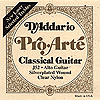
[ProArte J52 Alto Guitar set] Scale length: 540mm, Pitch A=440Hz
1st : unknown material 0.64mm (9.12kg)
2nd : unknown material, no mention of diameter nor tension
3rd : unknown material, no mention of diameter nor tension
4th : AltoGuitar Silverplated Wound, no mention of diameter nor tension
5th : AltoGuitar Silverplated Wound, no mention of diameter nor tension
6th : AltoGuitar Silverplated Wound, no mention of diameter nor tension
I summarized tension of this "ProArte Alto Guitar" string set used on 19th century guitar with a scale length of 620mm. I measured weight and length of the strings, made a tension table, and tried on a few instruments. As you can see below, they are relatively low tension except for the 1st. So, you can use them on some instruments.
[ProArte J52 Alto Guitar set] Scale Length: 620mm, Pitch A=440Hz
1st : hard nylon 0.63mm 0.34g (7.0kg), equivalent to 0.70mm nylon
2nd : hard nylon 0.72mm 0.45g (4.8kg), equivalent to 0.76mm nylon
3rd : hard nylon 0.82mm 0.57g (3.8kg), equivalent to 0.86mm nylon
4th : 1.34g (about 4kg)
5th : 2.20g (about 4kg)
6th : 3.42g (about 4kg)
[A set of strings specific for Pepe guitar]
Have you heard of Pepe series guitars? It's a small scale length guitar for children produced and distributed by Aria Co. They have several scale lengths of them and also produce strings and cases specifically for Pepe guitars. They can be found in specialty shops of guitars or in on-line shops that accept orders from international orders. 1st and 2nd strings are nylon and others are thin metal wound ones. In general, they are thin gauge and light tension set. However, I have not measured their tension accurately, yet.

[Hannabach Alto Guitar]
This is harder tensioned than ProArte's. I do not recommend them because they are expensive, but you can find some instruments that may fit to it.
Sample selections ... for Terz Guitar

 "ProArte Alto guitar string (J52)" or "Hannabach Alto guitar string" are relatively easy to find strings for Terz Guitars. A presumption on J52, though, is that the 1st string is to be replaced. You have to be careful on these, because they are assumed to be used on modern alto guitars. Even though their scale lengthes are fairly close, using strings for alto guitars on 19th century Terz Guitars sometimes is very dangerous. You have to feel the tension on each string while selecting these strings.
"ProArte Alto guitar string (J52)" or "Hannabach Alto guitar string" are relatively easy to find strings for Terz Guitars. A presumption on J52, though, is that the 1st string is to be replaced. You have to be careful on these, because they are assumed to be used on modern alto guitars. Even though their scale lengthes are fairly close, using strings for alto guitars on 19th century Terz Guitars sometimes is very dangerous. You have to feel the tension on each string while selecting these strings.
[ProArte, J52 Alto Guitar Set]

[ProArte, J52 Alto Guitar set] Scale length : 547mm, Pitch A=440Hz
1st (g') : Nylon (should be replaced with fishing line) 0.57mm (5.2kg)
2nd (d') : Hard Nylon 0.72mm (equivalent to 0.76mm nylon ; 5.0kg)
3rd (a#') : Hard Nylon 0.82mm (equivalent to 0.86mm nylon ; 4.3kg)
4th (f) : about 4.5kg
5th (c) : about 4.5kg
6th (G) : about 4.5kg
[[Hannabach Alto Guitar strings]
Harder tension than ProArte's. I'm not using them much these days.
[An example for 18th century style lady's guitar]
Terz tuning
L=552mm A=440Hz, total tension about 33kg
1st (g1) : 5.8kg, fluorocarbon 0.47mm (gut 0.56mm or nylon 0.60mm)
2nd (d1) : 5.6kg, fluorocarbon 0.62mm (gut 0.73mm or nylon 0.79mm)
3rd (a#) : 5.5kg, fluorocarbon 0.77mm (gut 0.91mm or nylon 1.00mm)
4th (f) : 5.4kg, VN5120 by Kuerschner (or 1012 by Pyramid)
5th (c) : 5.8kg, ProArte LightTension (VN5165 by Kuerschner or 1023 by Pyramid)
6th (G) : 5.7kg, VN5220 by Kuerschner (or 1234 by Pyramid)
Prime tuning (in case the same 18th century lady's guitar is tuned prime)
L=552mm A=440Hz, total tension about 30kg
1st (e1) : 6.0kg, fluorocarbon 0.57mm
(gut 0.66mm or nylon 0.73 mm)
2nd (b) : 5.7kg, fluorocarbon 0.74mm
(gut 0.88mm or nylon 0.94mm)
3rd (g) : 4.6kg, fluorocarbon 0.84mm
(gut 0.97mm or nylon 1.04mm)
4th (d) : 4.8kg, ProArte LightTension 4th
(VN5136 by Kuerschner or 1015 by Pyramid)
5th (A) : 4.1kg, ProArte LightTension 5th
(Augustine Black 5th about 5.0kg, VN5180 by Kuerschner 4.9kg, or 1026 by Pyramid 5.2kg)
6th (E) : about 5.0kg, Augustine Black 6th
(ProArte LightTension 6th 4.1kg, VN5240 by Kuerschner 5.0kg, or 1238 by Pyramid 5.0kg)
# Sample selections ... for lute

 For lute, baroque guitar, and viuela, nylon and fluorocarbon strings are widely in use and most of these can be substituted with fishing lines. The same is true for ukulele and mandlino. Some sample selections are listed below, but the selection depends on scale length of the instruments and the pitch you want to use on them. If you want selections for different scale length or pitch, you have to either consult with shops or ask the string manufacturers. When asking to the manufacturers, "type of the instrument", "scale length", "pitch of A", "extra length between nut and peg", and "tension you want to use" should be given to them. Alternatively, you can figure it out by yourself, if you have a string slide rule.
For lute, baroque guitar, and viuela, nylon and fluorocarbon strings are widely in use and most of these can be substituted with fishing lines. The same is true for ukulele and mandlino. Some sample selections are listed below, but the selection depends on scale length of the instruments and the pitch you want to use on them. If you want selections for different scale length or pitch, you have to either consult with shops or ask the string manufacturers. When asking to the manufacturers, "type of the instrument", "scale length", "pitch of A", "extra length between nut and peg", and "tension you want to use" should be given to them. Alternatively, you can figure it out by yourself, if you have a string slide rule.
6 course renaissance lute : total tension 28.325kg/2.7kg in average |
610mm A=440Hz
1st course (g1) : 3.4kg, Nylon 0.42mm or fluorocarbon 0.33mm (4 gauge)
2nd course (d1) : 3.0kg, nylon 0.52mm or fluorocarbon 0.41mm (6 gauge)
2nd course (d1) : 3.0kg, Nylon 0.52mm or fluorocarbon 0.41mm (6 gauge)
3rd course (a) : 2.8kg, Nylon 0.68mm or fluorocarbon 0.52mm (10 gauge)
3rd course (a) : 2.8kg, Nylon 0.68mm or fluorocarbon 0.52mm (10 gauge)
4th course (f1) : 2.8kg, Nylon 0.42mm or fluorocarbon 0.33mm (4 gauge)
4th course (f) : 2.8kg, Nylon 0.85mm or fluorocarbon 0.66mm (16 gauge)
5th course (c1) : 2.2kg, Nylon 0.50mm or fluorocarbon 0.41mm (6 gauge)
5th course (c) : 2.8kg, Gut 1.04mm or metal wound VN5104
6th course (g) : 2.2kg, Nylon 0.68mm or fluorocarbon 0.52mm (10 gauge)
6th course (G) : 2.65kg, Gut 1.36mm or metal wound VN5136
7 - 13 course renaissance lute : average 2.9kg |
600mm A=440Hz
1st course (g1) : 3.4kg, Gut 0.36mm, nylon 0.42mm, or fluorocarbon 0.33mm (4 gauge)
2nd course (d1) : 31kg, Gut 0.48mm, or nylon 0.54mm, or fluorocarbon 0.41mm (6 gauge)
2nd course (d1) : 3.1kg, Gut 0.48mm, nylon 0.54mm, or fluorocarbon 0.41mm (6 gauge)
3rd course (a) : 2.8kg, Gut 0.62mm, nylon 0.68mm, or fluorocarbon 0.52mm (10 gauge)
3rd course (a) : 2.8kg, Gut 0.62mm, nylon 0.68mm, or fluorocarbon 0.52mm (10 gauge)
4th course (f) : 2.7kg, Gut 0.76mm, nylon 0.85mm, or fluorocarbon 0.66mm (16 gauge)
4th course (f) : 2.7kg, Gut 0.76mm, nylon 0.85mm, or fluorocarbon 0.66mm (16 gauge)
5th course (c1) : 2.4kg, Gut 0.48mm, nylon 0.52mm, or fluorocarbon 0.41mm (6 gauge)
5th course (c) : 2.8kg, Gut 1.04mm or metal wound VN5104
6th course (g) : 2.4kg, Gut 0.64mm, nylon 0.70mm, or fluorocarbon 0.57/0.52mm (12/10 gauge)
6th course (G) : 2.8kg, Gut 1.40mm or metal wound VN5140
7th course (f) : 2.4kg, Gut 0.73mm, nylon 0.79mm, or fluorocarbon 0.62mm (14 gauge)
7th course (F) : 2.8kg, Gut 1.55mm or metal wound VN5155
8th course (e) : 2.4kg, Gut0.76mm, nylon 0.85mm, or fluorocarbon 0.66mm (16 gauge)
8th course (E) : 2.8kg, Gut 1.65mm, metal wound VN5165
(Tuning 8th course in D on 8 course lute, refer to D and d below.)
9th course (d) : 2.4kg, Gut 0.85mm, metal wound VN5085, nylon 0.94mm, or fluorocarbon 0.74mm (20 gauge)
9th course (D) : 2.8kg, Gut 1.85mm or metal wound VN5185
10th course (c) : 2.4kg, Gut 0.97mm, metal wound VN5097, nylon 1.04mm, fluorocarbon 0.79mm (22 gauge)
10th course (C) : 2.8kg, Gut 2.10mm or metal wound VN5210
11th course (B=H) : 2.8kg, Gut 1.08mm or metal wound VN5108
11th course (B1=H1) : 2.4kg, Gut 2.00mm or metal wound VN5200
12th course (A) : 2.8kg, Gut 1.24mm or metal wound VN5124
12th course (A1) : 2.4kg, Gut 2.30mm or metal wound VN5230
13th course (G) : 2.8kg, Gut 1.36mm or metal wound VN5136
13th course (G1) : 2.4kg, Gut 2.60mm or metal wound VN5260